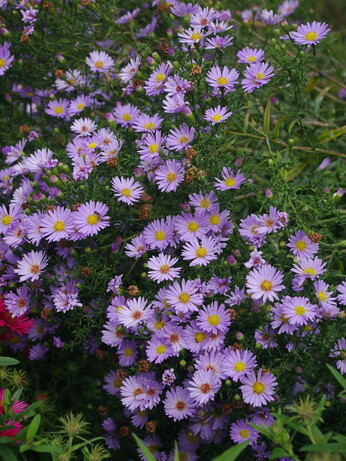Find out what the garden and propagation teams have been up to this week.

Our favourite perennials for late summer colour
Although we have entered the last month of summer, the garden still has plenty more colour and interest to offer us. It's a common misconception that once the height of summer has been passed, there are few, if any flowers still to be produced.
Fortunately this isn’t true and there are many late flowering perennials available which will bring colour to your garden throughout late summer and into autumn.
Here are some of our favourite late season perennials:
Agastache (giant hyssop)
A relative of sage and mint whose foliage is very aromatic when crushed, hence the common names of anise hyssop and Korean mint. More cultivated forms are being developed, expanding the range of late summer spikes of colour for a sunny border. Grows well with Geranium, Achillea and Echinacea.Flowers are very attractive to wildlife and their effect is enhanced by coloured calyces (the part of the plant holding the individual flowers). Best grown in a sunny border and a free-draining soil.
The iconic daisy flower is actually many flowers grouped together. The centre of the flower contains numerous disc-florets, normally yellow and the part of the flower of more interest to insects and wildlife. The ray-florets, which look like petals, have many colours and sizes and are normally the part which interests the gardener. This flower structure is the same for Doellingeria, Eurybia, Symphyotrichum and others in the invaluable Asteraceae family.
A fantastic late season flower with heads of colourful daisy-like flowers and scented foliage. Any we offer are cultivated hardy forms suitable for the garden. Plants prefer a rich and fertile soil in full sun.
Crocosmia (montbretia)
Crocosmias flower best in a humus-enriched soil, that does not dry out. Their bulbous roots will increase and flower freely when not overcrowded, so it is worth dividing in spring and replanting in fresh soil, in full sun or part shade. Flowers are produced in August and September, with a colour range of orange, yellow and red. Most hybrids are bred from two South African species, C. aurea and C. pottsii.
Echinacea (coneflower)
Traditionally colours of pink, purple and white were prominent, but the use of the yellow-flowered Echinacea paradoxa has encouraged a greater range of colours in new hybrids. As with others in the Asteraceae family, it's the ray-florets (the petal-like part of the flowers) which are most interesting, but the disc-florets in the centre are also prominent and remain strong and prickly, even after the colour has faded. Plants prefer a rich soil in full sun.
Helenium (sneezeweed)
Heleniums bring warm colour to the borders in late summer. This sun-loving perennial grows best in a general soil which doesn't dry out too much over the summer months. The velvety-brown central cone is surrounded by petals in yellow, orange and red.
Hylotelephium (syn. sedum)
Plants are well adapted to cope with drought conditions. On richer soils, they will grow taller, but are likely to fall out untidily from the centre. Colours range from white through to pinks and reds. The autumn flowering provides a very valuable nectar source for butterflies and other pollinating insects. Seed heads add impressive deep tones among the muted colours of winter. These can be cut down in late winter as new shoots gently emerge, developing into tidy clumps of fleshy foliage through spring and summer.
Rudbeckia (coneflower)
An adaptable, clump-forming perennial producing showy, yellow daisy flowers adding a blaze of colour to the borders from mid-summer well into autumn. Plants require full sun and a fertile, moisture retentive soil to thrive.
Sanguisorba (burnet)
The foliage is perhaps the only clue that these plants are a member of the rose family. With bottlebrush-like flowers interestingly opening from the bottom up, this genus has become quite the fashion, many widely used in prairie style planting. Ideal for a moderately fertile, well drained soil in sun or light shade.
Sidalcea (prairie mallow)
Reminding one of a miniature hollyhock, these garden varieties of mallow are easy, reliable plants for a reasonable soil in the sun. Although plants can be short lived, especially in heavier clay soils, cutting back after flowering will help encourage fresh foliage. Flowering from June until August, the plants have the tidy habit of shedding old flowers as they fade, keeping the plant looking neat and tidy.
The largest group of plants moved from Aster (about 90 species), almost all from America. It contains the widely grown Michaelmas daisies, S. novi-belgii, (New York asters) and S. novae-angliae, (New England asters). From our experience these have smoother leaves and smaller flowers than Aster. Many excellent cultivated forms available, with a rainbow of colours and some with lovely contrasting dark stems. Good for late colour in the herbaceous border, generally in full sun.
Vernonia (ironweed)
Another large genus of plants in the Asteraceae family, but relatively underused in UK gardens. From our experience it is an upright perennial with good sized flowers, white to purple-pink, more like Cirsium rather than Aster. Plants grow best in sun or part shade and a rich, fertile soil.
Read on: Ornamental Grasses for Autumnal Interest
![]()













COMMENTS